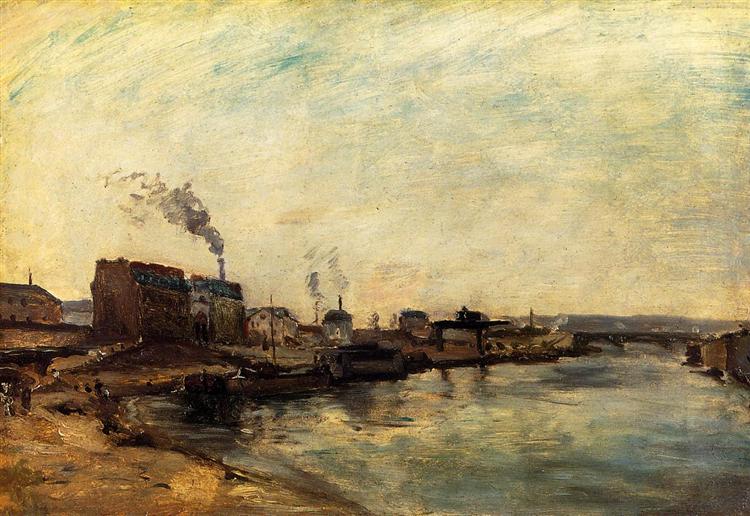Description
Paul Gauguin's Port de Grenelle, painted in 1875, offers a penetrating insight into everyday life and the Parisian environment during the second half of the 19th century. As one of the precursors of Post-Impressionism, Gauguin breaks with the conventions of his time through a careful consideration of light, color, and composition. This painting, although less known compared to his later works, reflects the artist's transition to a more personal and symbolic style that he will explore deeply in his career.
The composition of “Port de Grenelle” is characterized by a focus on balance and visual narrative. Through mere brush strokes, Gauguin captures the essence of an instant: the port, in its vitality, becomes a stage where life unfolds. The water, painted in cerulean and gray hues, acts as a mirror reflecting the sky, creating a connection between the ground and the ethereal. The anchored boats, outlined with rigid lines, add a sense of stability and stillness, contrasting with the fluidity of the water. The inclusion of boats, one of the main elements, suggests the commercial activity and social interaction typical of the time, providing a sense of movement that permeates the entire work.
The use of colour in this work stands out as a key element in the visual narrative. The palette is a mix of deep blues and greens, interspersed with touches of white and warm tones that breathe a serene atmosphere. This treatment of colour, characteristic of Gauguin's early work, reflects his admiration for natural light, very much in the style of the Impressionists, although he himself distinguished himself by avoiding the purity of colour often found in the works of his contemporaries. Through this choice of colour, he brings a sense of depth and warmth, inviting the viewer to experience not only what is seen, but what is felt when contemplating this scene.
In the context of the work, the presence of human figures represents a fascinating aspect that deserves to be explored. Although the figures are not the central focus of the composition, their inclusion is essential to understanding the social environment of the port. The figures, visible in the distance, move about with a calm that seems to integrate everyday life into the natural scene. Gauguin does not resort to elaborate details in the figures, but rather uses them as stylized props that complement the composition, suggesting interaction and life in the port without distracting from the landscape.
"Port de Grenelle" not only stands as a visual document of a specific place and time in Paris, but also serves as a manifestation of Gauguin's aesthetic and thematic interests. This shifting of his focus from the representational to a more symbolic use of color and form can be seen as a foreshadowing of his future experiments. His desire to capture the essence of life and human experience, moving away from mere naturalistic representation, makes him a key figure in the evolution of modern art.
In conclusion, "Port de Grenelle" is a work that, although emanating the atmosphere of impressionism, anticipates the more symbolic and expressionist currents that Gauguin would develop later in his career. The painting not only invites observers to an aesthetic appreciation of the Parisian port, but also offers them a passage to the exploration of the human condition and the interaction of man with his environment. Thus, through this work, Paul Gauguin establishes the bases of his artistic career, proposing a dialogue between the real and the symbolic that will be fundamental in the history of art.
KUADROS ©, a famous painting on your wall.
Hand-made oil painting reproductions, with the quality of professional artists and the distinctive seal of KUADROS ©.
Painting reproduction service with satisfaction guarantee. If you are not completely satisfied with the replica of your painting, we will refund 100% of your money.

